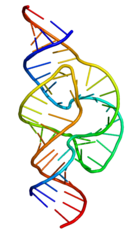Comparative genomics is a promising direction in studying the function of junk DNA. Biologically functional sequences, as the theory goes, tend to undergo mutation at a slower rate than nonfunctional sequence, since mutations in these sequences are likely to be selected against. For example, the coding sequence of a human protein-coding gene is typically about 80% identical to its mouse ortholog, while their genomes as a whole are much more widely diverged. Analyzing the patterns of conservation between the genomes of different species can suggest which sequences are functional, or at least which functional sequences are shared by those species. Functional elements stand out in such analyses as having diverged less than the surrounding sequence.
Comparative studies of several mammalian genomes suggest that approximately 5% of the human genome has evolved under purifying selection[14] since the divergence of the mammals. Since known functional sequence comprises less than 2% of the human genome, it appears that there may be more functional "junk" DNA in the human genome than there is known functional sequence.
A surprising recent finding was the discovery of nearly 500 ultraconserved elements[15], which are shared at extraordinarily high fidelity among the available vertebrate genomes, in what had previously been designated as junk DNA. The function of these sequences is currently under intense scrutiny, and there are preliminary indications[15][16][17] that some may play a regulatory role in vertebrate development from embryo to adult.
It must be noted that all present results concerning evolutionarily conserved human "junk" DNA are expressed in highly preliminary, probabilistic terms, since only a handful of related genomes are available. As more vertebrate, and especially mammalian, genomes are sequenced, scientists will develop a clearer picture of this important class of sequence. However, it is always possible, though highly unlikely, that there are significant quantities of functional human DNA that are not shared among these species, and which would thus not be revealed by these studies. Conversely there are even some questions about basic hypothesis that conserved sequences all must function [13].
On a theoretical note, it is often observed that the presence of high proportions of truly nonfunctional "junk" DNA would seem to defy evolutionary logic. Replication of such a large amount of useless information each time a cell divides would waste energy. Organisms with less nonfunctional DNA would thus enjoy a selective advantage, and over an evolutionary time scale, nonfunctional DNA would tend to be eliminated. If one assumes that most junk DNA is indeed nonfunctional, then there are several hypotheses for why it has not been eliminated by evolution: (1) The energy required to replicate even large amounts of nonfunctional DNA is in fact relatively insignificant on the cellular or organismal scale, so no selective pressure results (selection coefficients less than one over the population size are effectively neutral); (2) The aforementioned possible advantage of having extra DNA as a reservoir of potentially useful sequences and similarly as a protective buffer against harmful genetic damage or mutations; and (3) Retrotransposon insertions of nonfunctional sequence occurring faster than evolution can eliminate it. These are all hypotheses for which the time scales involved in evolution may make it difficult for humans to investigate rigorously.
http://en.wikipedia.org/wiki/Junk_DNA









